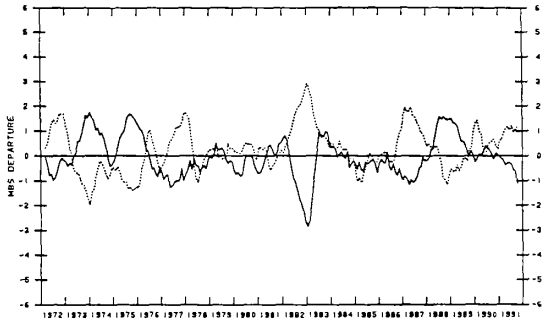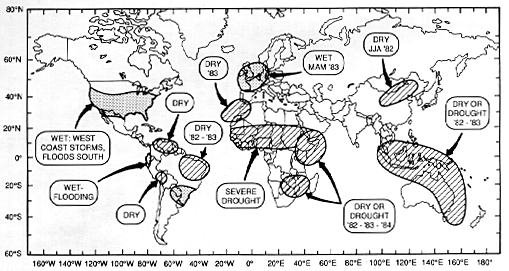 |
| Five-month running mean of the sea level pressure anomalies at Darwin (dashed) and Tahiti (solid) (Climate Analysis Center, 1991: Climate Diagnostics Bulletin, November. Washington, DC: US Department of Commerce. |
El Niño is a term originally used to describe the appearance of warm (surface) water from time to time in the eastern equatorial Pacific region along the coasts of Peru and Ecuador. It was once suggested that minor El Niño events occurred about every two to three years and major ones about every eight to 11 years. Today, scientists note that El Niño has a return period of four to five years. When an El Niño event occurs, it often lasts from 12 to 18 months.
La Niña refers to the appearance of colder-than-average sea surface temperatures (SSTs) in the central or eastern equatorial Pacific region (the opposite to conditions during El Niño). Many scientists do not like the use of the term and prefer to call it a cold event (described below).
A warm event refers to the anomalous warming of SSTs in the central and eastern equatorial Pacific. This term is being used to avoid confusion over the use of other terms like ENSO and El Niño. A warming in the regions mentioned is accompanied by a relative cooling in the western equatorial Pacific.
A cold event is one where the SSTs become anomalously colder compared to the long-term average for the central and eastern equatorial region. (It is the opposite of a warm event in that region.) It has been referred to in the past as anti-El Niño and, more recently, as La Niña. La Niña, however, unlike the restrictive view of El Niño, is applied to Pacific basinwide phenomena.
The Southern Oscillation is a see-saw of atmospheric mass (pressure) between the Pacific and Indo-Australian areas. For example, when the pressure is low in the South Pacific high pressure cell and high over Indonesia and Australia, the Pacific trade winds weaken, upwelling of cool water on the Pacific equator and along the Peruvian coast weakens or stops, and SSTs increase in these areas where the upwelling weakens.
The Southern Oscillation Index (SOI) has been developed to monitor the Southern Oscillation using the difference between sea level pressures at Darwin, Australia, and Tahiti, although other stations have sometimes been used. Large negative values of the SOI indicate a warm event, and large positive values indicate a cold event (also referred to as La Niña). It is important to note that there is not a one-to-one correspondence between the occurrence of Southern Oscillation events and El Niño events, using the spatially restrictive original definition of El Niño.
ENSO is the term currently used by scientists to describe the full range of the Southern Oscillation that includes both SST increases (a warming) as well as SST decreases (a cooling) when compared to a long-term average. It has sometimes been used by scientists to relate only to the broader view of El Niño or the warm events, the warming of SSTs in the central and eastern equatorial Pacific. The acronym, ENSO, is composed of El Niño-Southern Oscillation, where El Niño is the oceanic component and the Southern Oscillation is the atmospheric component of the phenomenon. The broader definition of El Niño has sometimes been used interchangeably with ENSO, because ENSO is less well known in the popular electronic and printed media.
Teleconnections can be defined as atmospheric interactions between
widely separated regions. They have been identified through statistical
correlations (in space and time). Some of these correlations have been
used to generate hypotheses about geophysical processes related to teleconnections.
Most countries in the world are, or should be, interested in this aspect
of the Southern Oscillation. Some examples are provided in the following
maps.
 |
| Five-month running mean of the sea level pressure anomalies at Darwin (dashed) and Tahiti (solid) (Climate Analysis Center, 1991: Climate Diagnostics Bulletin, November. Washington, DC: US Department of Commerce. |
 |
| Selected extreme temperature events that persisted for a season or longer in the 1982-84 period. (WMO, 1984: The Global Climate System: A Critical Review of the Climate System During 1982-1984. Genever WMO.) |
 |
| Selected extreme continental precipitation (wet and dry areas) that persisted for a season or longer in the 1982-84 period (WMO, 1984: see above.) |